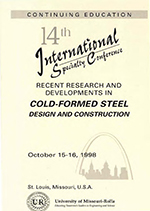Session Dates
15 Oct 1998
Abstract
The moment capacity of a laterally braced cold-formed steel flexural member with edge stiffened flanges (e.g., a channel or zee section) may be adversely affected by local or distortional buckling. Traditional design methods recognize the need to explicitly account for local buckling, but not distortional buckling. Experimental data and numerical analyses suggest that proper strength prediction of laterally braced cold-formed steel flexural members requires explicit treatment of distortional buckling. New procedures for hand prediction of the buckling stress in the local and distortional mode are presented. Numerical investigations are employed to highlight post-buckling behavior unique to the distortional mode. A new design method for flexural members is presented. The method integrates distortional buckling into the unified effective width approach currently used in most cold-formed steel design specifications. Comparison to experimental tests shows the viability and advantages of the new approach.
Department(s)
Civil, Architectural and Environmental Engineering
Research Center/Lab(s)
Wei-Wen Yu Center for Cold-Formed Steel Structures
Meeting Name
14th International Specialty Conference on Cold-Formed Steel Structures
Publisher
University of Missouri--Rolla
Document Version
Final Version
Rights
© 1998 University of Missouri--Rolla, All rights reserved.
Document Type
Article - Conference proceedings
File Type
text
Language
English
Recommended Citation
Schafer, Benjamin W. and Pekoz, Teoman, "Laterally Braced Cold-formed Steel Flexural Members with Edge Stiffened Flanges" (1998). CCFSS Proceedings of International Specialty Conference on Cold-Formed Steel Structures (1971 - 2018). 4.
https://scholarsmine.mst.edu/isccss/14iccfsss/14iccfsss-session1/4
Laterally Braced Cold-formed Steel Flexural Members with Edge Stiffened Flanges
The moment capacity of a laterally braced cold-formed steel flexural member with edge stiffened flanges (e.g., a channel or zee section) may be adversely affected by local or distortional buckling. Traditional design methods recognize the need to explicitly account for local buckling, but not distortional buckling. Experimental data and numerical analyses suggest that proper strength prediction of laterally braced cold-formed steel flexural members requires explicit treatment of distortional buckling. New procedures for hand prediction of the buckling stress in the local and distortional mode are presented. Numerical investigations are employed to highlight post-buckling behavior unique to the distortional mode. A new design method for flexural members is presented. The method integrates distortional buckling into the unified effective width approach currently used in most cold-formed steel design specifications. Comparison to experimental tests shows the viability and advantages of the new approach.



